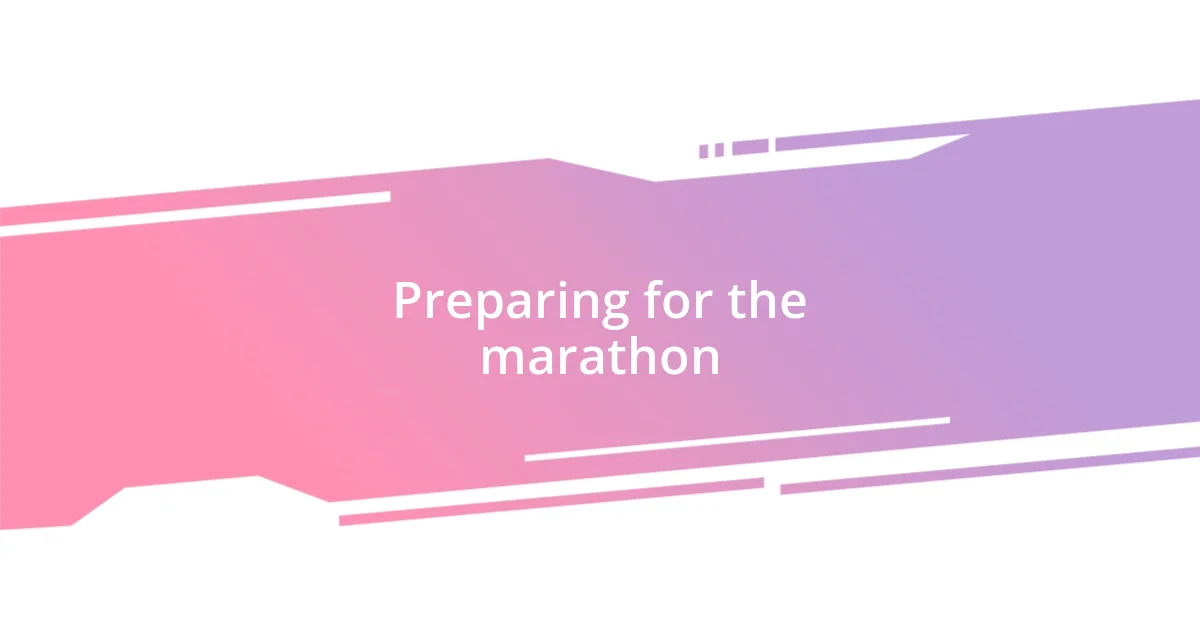Key takeaways:
- Nutrition and mental preparation are crucial for marathon training, influencing physical performance and confidence.
- Setting realistic goals and celebrating small achievements fosters motivation and patience throughout the marathon journey.
- Post-race recovery, including rest and proper nutrition, is essential for restoring the body and preventing fatigue.

Preparing for the marathon
Preparing for my first marathon was a journey of both physical and mental transformation. I vividly remember lacing up my running shoes for those early morning training sessions when the air was still crisp and quiet. Did I really think I could do this? Each run felt like a conversation with myself, gradually building my confidence and endurance.
During my training, I discovered that nutrition plays a crucial role in marathon preparation. I learned the hard way that what you fuel your body with matters. I still recall the day I tried to run a long distance on just a coffee and a granola bar. Let’s just say, my body had a very different idea of what ‘run’ means! Balancing carbs, proteins, and hydration became an essential part of my routine; it was a game-changer.
Moreover, I found that mental preparation was just as important as the physical side. I often visualized crossing that finish line, a moment that lingered in my mind as motivation through those grueling training days. It’s fascinating how imagination can push you through those last painful miles, don’t you think? I learned to embrace the uncertainty and anxiety, using it to fuel my determination. It was all about shifting my mindset and understanding that every effort was a step closer to my goal.

Setting realistic goals
Setting realistic goals is crucial when embarking on the marathon journey. I remember when I first decided to run a marathon; I naively thought I could just jump into it without a proper plan. A few weeks into training, I faced the harsh reality of my overzealous ambitions. I realized the importance of breaking down the massive challenge into smaller, achievable milestones. It became an exercise in patience and persistence, and my perspective shifted as I learned to appreciate each small victory along the way.
Here are some key points to consider when setting your marathon goals:
- Assess your current fitness level: Understand where you stand now so you can set attainable targets.
- Set progressive milestones: Break your training into phases, such as starting with 5K runs before working your way to longer distances.
- Be flexible: Life can throw curveballs; adapt your goals as needed and focus on the journey, not just the finish line.
- Celebrate small successes: Whether it’s completing a long run or improving your pace, acknowledge your progress—it fuels motivation.
- Listen to your body: Pay attention to how you feel on your runs. Adjust your goals if you’re experiencing pain or fatigue; it’s not a setback, just part of the process.
The reality is, achieving a marathon isn’t just about the race day; it’s the accumulation of every training run and lesson learned along the way.

Training regimen and routines
Training for my first marathon was like piecing together a complicated puzzle. Each run, whether a short jog or a long distance trek, served a purpose in my steadily evolving routine. I remember vividly those weekends where I’d wake up before sunrise to tackle my long runs. It often felt lonely on those quiet roads, but the solitude helped me reflect on my progress and strengthen my resolve. Each gnawing muscle ache was a reminder that I was building my endurance, both physically and mentally.
As I delved deeper into my training regimen, I realized the structure played a significant role in my success. I established a weekly schedule that included a mix of easy runs, tempo runs, and rest days. This balance became my secret weapon. On particularly tough days, when motivation waned, I’d draw from my experiences—remembering the first time I managed to run five miles without stopping. Those little victories kept me going and transformed my dreaded training runs into opportunities for personal growth.
I also experimented with cross-training activities like cycling and swimming. It was initially daunting to add variations, but incorporating these workouts helped me stay injury-free and mentally fresh. Plus, who would have thought that pedaling away on a bike while listening to upbeat music could be so invigorating? It turned out to be an essential part of the training regimen that I grew to cherish.
| Training Components | Description |
|---|---|
| Long Runs | Building endurance; typically done on weekends |
| Tempo Runs | Improving speed; generally shorter but at a faster pace |
| Cross-Training | Incorporating other activities like cycling or swimming |
| Rest Days | Essential for recovery and muscle repair |

Overcoming mental barriers
The mental barriers I faced during my marathon journey often felt like a wall I couldn’t climb. There were moments, especially on those long training runs, where self-doubt crept in, making me question my decision to even attempt such a feat. I vividly recall a day when I hit the wall at mile 14, overwhelmed by the thought of running twice that distance on race day. It was a dark cloud over my spirit, but I learned to combat it by focusing on each step. I’d tell myself, “One mile at a time,” and suddenly, each mile became a manageable goal.
It’s intriguing how our minds can make or break our progress. I remember standing at the start line, wrestling with feelings of fear and anxiety. What if I couldn’t finish? But then, I thought about all the training—the early mornings and late evenings dedicated to lacing up my shoes and hitting the pavement. That realization gave me strength. Instead of letting negativity take hold, I transformed my fears into motivation. After all, I had already conquered countless miles in training. Why should race day be any different?
The power of positive affirmations played a surprising role as well. Before my runs, I began repeating mantras like, “I am strong, I am ready,” until those words transcended from mere phrases into beliefs. During the race, when fatigue set in, those affirmations would echo in my mind, pushing me forward. It’s amazing how something so simple can shift your mental landscape. Have you ever tried this technique? Trust me; it can redefine your limits and alter your marathon experience in ways you might not expect.

Race day experiences
The atmosphere on race day was electric. As I stood among thousands of fellow runners, I could feel my heart racing with excitement and nerves. The sheer energy was contagious—the sweat, laughter, and shared anticipation seemed to create an unspoken bond among us. I remember looking at the runners around me, each of us with our unique stories and motivations, and thinking, “Wow, we’re all in this together.” It was the perfect blend of community and competition.
As the race began, I found myself swept away by the momentum of the crowd. Early on, I mistakenly believed I could keep pace with a faster group, which quickly turned into a reality check. At mile five, my legs started screaming for mercy, and I realized my earlier bravado might have been a bit too ambitious. It was both humbling and enlightening; sometimes, you need to recognize your limits to truly appreciate your strengths. In that moment, I reminded myself that it was okay to run my own race, and that’s precisely what I did.
The emotional rollercoaster during the race was unlike anything I’d ever experienced. There were moments of pure joy, like crossing an unexpected cheer zone filled with friends holding homemade signs and blasting music that made me dance through my fatigue. Yet, there were also points of deep struggle. At around mile 20, I hit another wall—my body felt like a lead weight. But instead of focusing on the pain, I reflected on the countless early mornings I’d sacrificed and the support from friends and family. That reflection ignited a spark in me. It made me realize that every mile was not just a number but a testament to every ounce of effort I’d poured into this journey. Have you ever faced such a pivotal moment? I certainly found that I could draw on those reservoirs of strength when I needed it most.

Post-race recovery strategies
The importance of post-race recovery cannot be overstated. After crossing that finish line, my body felt like it was made of lead. I discovered that foam rolling became my best friend. It helped alleviate the muscle tightness and soreness that settled in after my marathon. Have you ever tried foam rolling? It’s a game changer—similar to giving your muscles a gentle massage that helps them recover faster.
Hydration and nutrition played crucial roles in my recovery strategy. I learned the hard way that neglecting these aspects could lead to prolonged fatigue. After the race, I focused on replenishing electrolytes and fueling my body with a balanced meal that included protein and carbs. I remember sitting down with a delicious plate of grilled chicken, quinoa, and veggies. It felt satisfying not just because I was hungry, but because I knew I was taking an essential step toward recovery.
Rest was another key element that I initially underestimated. I found myself itching to get back into running within a couple of days, but I resisted that urge. Listening to my body proved vital as I gave myself permission to truly rest. I spent the days following the race indulging in more sleep and gentle stretching, which helped me feel revitalized quicker than I expected. How often do we let the excitement of achievement overshadow our need for rest? Taking that well-deserved break was a lesson in patience, and it reinforced the importance of self-care in the recovery process.

Lessons learned from the marathon
Reflecting on my marathon experience, one of the biggest lessons I learned was the significance of pacing. Early in the race, I thought I could maintain a quicker speed, driven by the thrill of the crowd. As I reached the halfway mark, it became painfully clear that I had overestimated my ability. This taught me that confidence must be balanced with strategy. How often do we rush into situations without a plan? I now understand the value of patience and calculated endurance, not just in running but in various aspects of life.
Another key takeaway was the power of mental resilience. At mile 20, I confronted my demons—every “I can’t” echoed in my mind. But as I found myself faltering, I discovered an inner voice urging me to push forward. It dawned on me that perseverance wasn’t just about physical strength; it was about cultivating a mindset that embraces challenges. Have you ever experienced a moment where your thoughts seemed more daunting than the actual task? I certainly did, and that realization has reshaped how I tackle obstacles beyond the race course.
Additionally, the camaraderie of my fellow runners opened my eyes to the strength of community support. When I saw strangers encouraging one another, sharing water, or just exchanging a smile, I felt an overwhelming sense of connection. This shared journey reminded me that no one succeeds in isolation; we all need a network that lifts us, especially during trying times. Isn’t it powerful to know that even a simple gesture can inspire someone to keep going? This collective spirit underscored my experience, reinforcing that together, we can achieve far more than we ever could alone.














